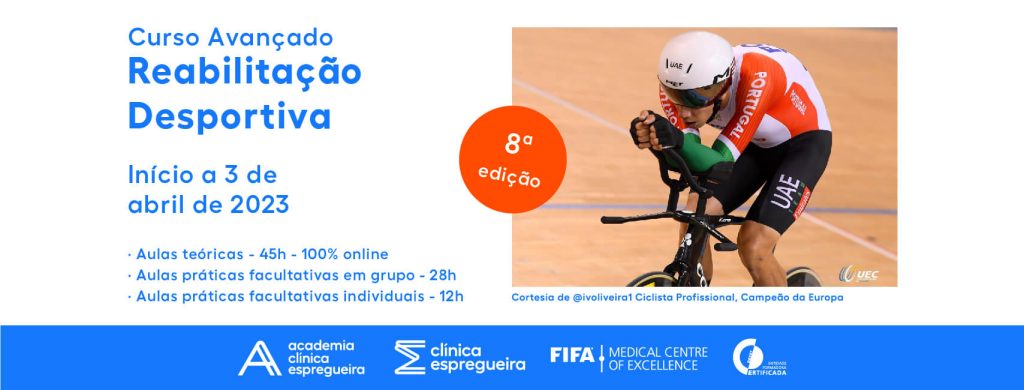Soccer is the world's most popular sport and the one with the largest number of participants. However, it is also the sport with the highest incidence of injuries, particularly lower limb injuries.
FIFA - International Federation of Football and its medical commission have as one of their main concerns the protection and promotion of athletes' health, thus, the reduction and prevention of injuries instead of control and intervention has become one of its main goals.
In soccer there are two major groups of injuries: contact and non-contact injuries. Game rules, when implemented correctly and strictly, fair play education and technical skill development have a positive effect and seem to be effective in reducing contact injuries. Measures that reduce and help prevent non-contact injuries were lacking.
To fill the above mentioned gap FIFA and its Medical Assessment and Research Centre (F-Marc, Medical Assessment at Research Centre) developed in 2006 a warm-up exercise plan for the prevention and reduction of the most common lower limb injuries in soccer.
The literature has confirmed the preventive effect of this program by showing that teams that have implemented the FIFA 11+ program have a 30 to 70% reduction in the number of injuries. In addition to the preventive effect, studies have also shown an increase in performance and motor skills (agility, dynamics, balance, jumping power, and technical skills.
The effectiveness of Fifa 11+ programs in injury prevention can be observed within 10 - 12 weeks of application. However, it depends on how often the program is applied in the training-game micro-cycle.
Given the good results of this first prevention program, FIFA has decided to adapt and develop new programs aimed at a different target group, namely children (FIFA 11+ Kids) and referees (FIFA 11+ Referees). Moreover, with the increase in the number of upper limb injuries in recent years, an upper limb prevention program (FIFA 11+ Shoulder) has also been developed, aimed primarily at goalkeepers.
FIFA 11+
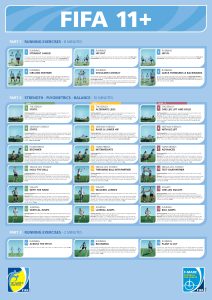 No. of exercises
No. of exercises
15 exercises
Structure
Program divided into 3 parts:
- Part 1 - Low-speed running exercises combined with active stretching and controlled player-to-player contact;
- Part 2 - Exercises focused on lower limb and core strength, balance, pliom etrics, and agility. All of these exercises have 3 levels of difficulty;
- Part 3 - Moderate/high speed running exercises combined with holding/starting movements.
* In the warm-up games only part 1 and part 2 are performed.
Target Population Group
Amateur and professional soccer, male and female, ages 14 and up.
Runtime
20 minutes
When to perform
Replaces warm-ups for training and games, at least twice a week.
Key elements of the injury prevention program
- Core stability;
- Neuromuscular control and balance;
- Eccentric strength of the thigh muscles;
- Pliometrics and agility.
FIFA 11+ Kids
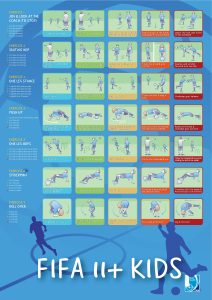 No. of exercises
No. of exercises
7 exercises
Structure
The exercises contain 5 levels with progressively increasing difficulty.
*Level change must be individualized for each athlete, in each exercise.
Target Population Group
Male and female soccer athletes, ages 7 to 13.
Runtime
15 to 20 minutes
* Once the players have learned the exercises.
When to perform
Replaces warm-up before training.
Key elements of the injury prevention program
- Coordination and balance;
- Core and lower limb muscle strength;
- Optimization of drop techniques.
FIFA 11+ Shoulder
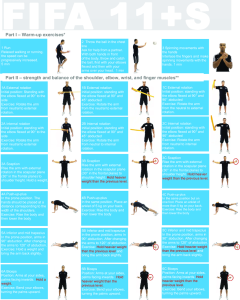 No. of exercises
No. of exercises
19 exercises
Structure
Program divided into 3 parts:
- Part 1 - General warm-up exercises.
- Part 2 - Exercises to increase strength, endurance and stability of the muscles of the shoulder, elbow, wrist and fingers. It should be performed with low training loads (2 - 3 kg) and a high number of repetitions (3 sets of 15 to 20 repetitions). All exercises included in this part have three levels of difficulty (A, B, and C).
- Part 3 - Exercises for core stability and neuromuscular control. These exercises should be performed at high speed for 5 to 6 sets with 15 to 20 repetitions.
Target Population Group
Soccer and futsal goalkeepers, amateur and professional, female and male, between the ages of 7 and 13.Runtime
20 to 25 minutes (part 1 - 7 minutes; part 2 - 9 to 10 minutes; part 3 - 9 to 10 minutes).
* Once the players have learned the exercises.When to perform
Replaces warm-up before training, 3 times a week.
Key elements of the injury prevention program
- Core stability;
- Neuromuscular control;
- Eccentric rotator muscle strength;
- Agility.
FIFA 11+ Referees
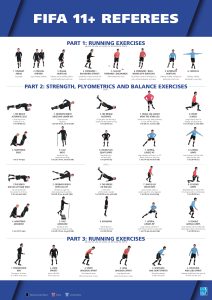 No. of exercises
No. of exercises
18 exercises
Structure
Program divided into 3 parts:
- Part 1 - Running exercises;
- Part 2 - Specific exercises to focus on increasing strength, balance, and agility of the core and lower limbs. All exercises in this part have two levels of progressive difficulty.
- Part 3 - Running exercises.
* In the warm-up games only part 1 and part 2 are performed.
Target Population Group
Referees, male or male, professional or amateur soccer.
Runtime
20 minutes
* Once the players have learned the exercises.
When to perform
It replaces warm-ups before practices and games, at least twice a week.
Key elements of the injury prevention program
- Core stability;
- Neuromuscular control and balance;
- Eccentric hamstring work;
- Pliometrics and agility.
Considerations to take into account when implementing FIFA prevention programs: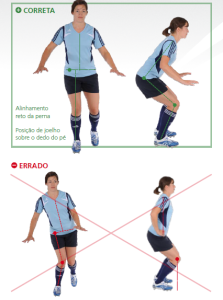
- The programs have been intentionally developed in a progressive way, and therefore the exercises must be performed sequentially;
- On average it takes 2 to 3 trainings for all athletes on a team to learn the exercises correctly in the least degree of difficulty;
- Instructions should be short, clear and precise;
- During the execution of the exercises, the importance of postural correction and the control and alignment between the different body segments must be emphasized;
- Exercises should start with a low number of repetitions and short distances. Only when performed correctly should you progress;
- In the above mentioned programs, for there to be evolution in the level of exercises that present different degrees of difficulty (FIFA 11+ kids and FIFA 11+ parts 2, FIFA 11+S, FIFA 11+ Referees), these must be performed correctly and without difficulty, in a specific time and with considerable progression in the number of repetitions;
- Changes in exercise level should be done on an individual basis for each athlete. It can be expected that in 3-4 weeks the entire squad will be able to move up a level.
FIFA prevention programs have as main benefits the reduction of injuries, reduction of costs and improvement of performance. Its implementation is the responsibility of coaches, sports professionals, physiotherapists, doctors, ... Both the medical team and the technical team play a key role.
The practical operationalization of the FIFA 11+ program will be explored in the course advanced in Sports Rehabilitation of Academia Clínicas Espregueira.
Advanced Course in
Sports Rehabilitation
